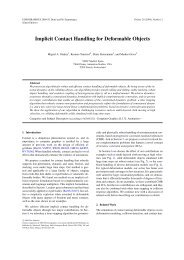Perceiving affordances in virtual reality: Influence of person ... - GMRV
Perceiving affordances in virtual reality: Influence of person ... - GMRV
Perceiving affordances in virtual reality: Influence of person ... - GMRV
Create successful ePaper yourself
Turn your PDF publications into a flip-book with our unique Google optimized e-Paper software.
4.3 The Virtual Environment<br />
In the <strong>virtual</strong> environment (see Fig. 2), the participant was <strong>in</strong>side a room (width:<br />
8.5 m × height: 4 m × length: 8.5 m) and stood upright 1 m from a slanted surface<br />
(width: 0.76 m × length: 1.56 m × thickness: 0.02 m). There were no contextual<br />
cues <strong>in</strong> the room. The floor <strong>of</strong> the room was displayed with a grey carpet, the<br />
walls and the ceil<strong>in</strong>g with a brown pa<strong>in</strong>t. A wooden texture was used for the<br />
slanted surface. The participant’s <strong>virtual</strong> eye height (i.e., the position <strong>of</strong> the<br />
camera) corresponded to the actual participant’s eye height.<br />
Fig. 2 The <strong>virtual</strong> environment was made up <strong>of</strong> a room with a wooden slanted surface. Left: the<br />
participant’s view. Right: a side view.<br />
4.4 Procedure<br />
The participant’s task <strong>in</strong> this experiment was to determ<strong>in</strong>e whether a wooden<br />
surface with a given <strong>in</strong>cl<strong>in</strong>ation would support normal upright posture. Normal<br />
upright posture was def<strong>in</strong>ed as stand<strong>in</strong>g with the feet flat (i.e., not on the toes)<br />
without bend<strong>in</strong>g at the hip or knees. Before the experiment, each participant<br />
was briefed about the task and was <strong>in</strong>structed to stay upright dur<strong>in</strong>g experiment.<br />
The participant was allowed to move the head <strong>in</strong> order to explore the <strong>virtual</strong><br />
environment. Once equipped with the HMD and the opaque fabric (see Fig. 1), the<br />
participant was led <strong>in</strong> front <strong>of</strong> the table with the laptop. The experimenter pressed<br />
the Enter key to start the presentation <strong>of</strong> the <strong>virtual</strong> environment with the slanted<br />
surface; and pressed aga<strong>in</strong> the Enter key when participant began respond<strong>in</strong>g<br />
<strong>in</strong> order to measure his (her) response time. The experimenter recorded the<br />
perceptual response (i.e., “yes” the surface would support upright posture or<br />
“no”, it would not). Participants also reported their confidence <strong>in</strong> their judgments<br />
8





